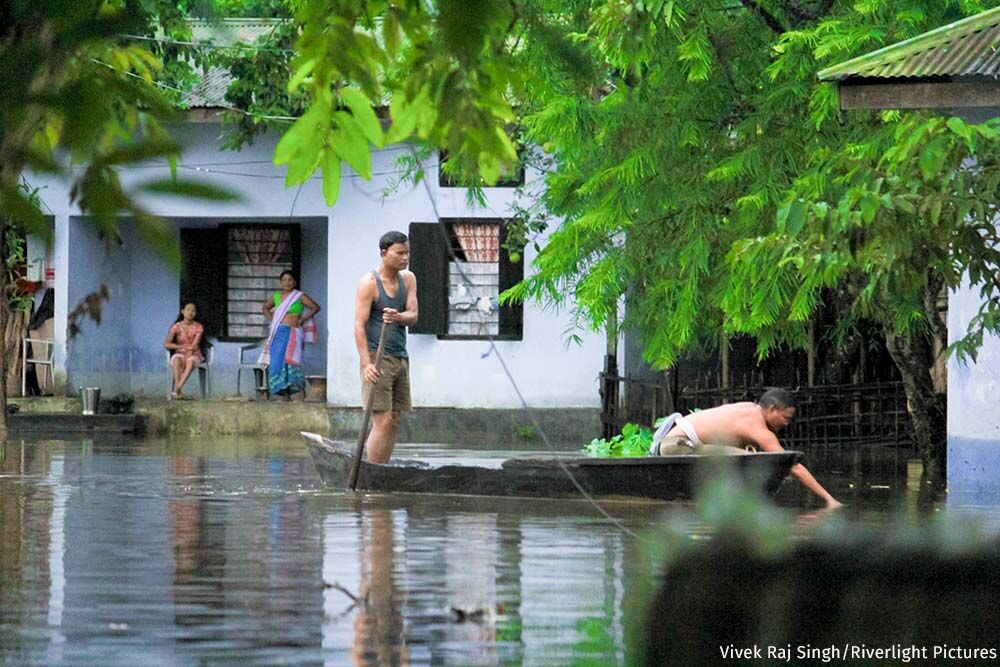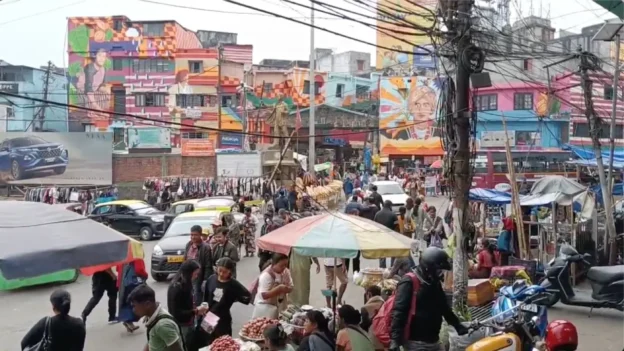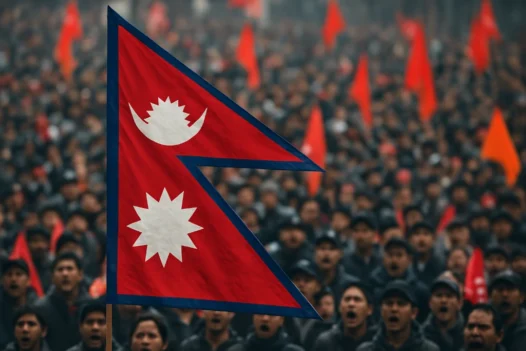The uncertainty of life and livelihoods is forcing many to migrate from the temporary silt islands, locally known as chars or saporis.
Editor’s Note: By May, the North-east was already reeling from extensive flooding following bouts of above average rainfall. The Assam State Disaster Management Authority announced that thousands of villages, and over 110,000 hectares of crop area, had been affected across the state, which was briefly cut off from the rest of India. Barely had the region begun to recover, when heavy rainfall swept across Assam, Meghalaya, Arunachal Pradesh and other parts of the region, shredding infrastructure like roads and bridges, disrupting rail links and snapping telecommunications. A deadly combination of high water and winds, landslides and erosion struck. By June 22, 88 people had died in Assam and 35 were missing in the floods that have impacted 34 districts. Over 400,000 were sheltering in camps; nearly 125,000 houses were damaged, and 67,290 animals had died, data from the Disaster Management Division of the Ministry of Home Affairs says.
This story was reported on before the current Assam floods, but it explores the uncertain and precarious lives and livelihoods of inhabitants of the state as they battle recurrent flooding of the Brahmaputra and its companion rivers..
THE BRAHMAPUTRA, one of the most sediment-laden rivers in the world, is home to a geographical phenomenon–a unique network of an estimated 2,300-plus islands that result from the vast quantities of sand, silt and rock that the river carries along its course, down from the mountains and onto the plain.
The silt and sand accumulate along its flow to form temporary islands. The rocks that tumble along in its course, and the sediment the river carries, give these islands body. Most of these islands are impermanent–literally shifting sands, except for a few very large ones. The biggest of them, Majuli, is the world’s largest river island. Even after it has shrunk to a third of its original size, thanks to erosion, it is still vast, spreading over 400 sq km–nearly as large as the capital of Rajasthan, Jaipur. Once you are there, you do not realise that you are on an island in the midst of a mighty river.
These temporary islands, locally known as chars or saporis, are in a constant state of flux. The river builds them, and then washes parts of them away–sometimes even an entire small island or shoal disappears–during the periodic floods. The floodwaters carry the silt away only to recreate the islands elsewhere, in an ongoing cycle of land building and destruction.
Since most of these islands are impermanent, their ownership is unclear. They are also extremely fertile–thus, for generations, local communities have settled on these islands as they take shape, living in homes of bamboo and mud, establishing homesteads, raising families and eking out a living through farming and fishing.
When the floods come, people fend for themselves in relief camps, or in temporary shelters along the embankments criss-crossing the flood plains, and even on boats. Once the floods recede, they return to find, at times, that ‘their’ home island has shifted downstream, sometimes as much as a few kilometres, and that they have to start all over again. This process is cyclical; sometimes they have to go through this process a few times every year, depending on the number of floods and their ferocity. Stress is a constant companion.

These islands are home to nearly a tenth of Assam’s population of 35 million, and to a diverse range of communities, including some who live in a national park. Also resident on these chars are many species of wildlife including elephant herds, wild buffalo and feral horses as well as migratory and local birds, while the endangered river dolphins are occasionally sighted in the river and its tributaries.
This space is a universe apart. Buffaloes wallow or swim in the shallows; a fisherman steers his dugout towards our boat and offers us a glowing golden carp–his catch of the day, a whopping one-and-a-half kilos, for Rs 800; an unfinished wooden bridge, with pillars but no top, stands stark against the skyline, silent and accusing. A country boat sputters a careful course through the spaces between the large pillars.
This is the second part of our series, ‘Reflections From A River’, exploring the riverine ecosystem of the Brahmaputra. You can read the first part here.
ON KOBU sapori in Dhemaji district–one of the better known and older islands on the river–a small group of men from different communities gathers in the local primary school to speak with their visitors.
It has taken us over an hour and a half to get here from the nearest ferry point–which is really nothing more than the bank where boats anchor to take on passengers and goods. The one we hire is a noisy country boat about 20 metres long, with an engine that splutters indignantly when it is turned on, sinks into an occasional coma, and as suddenly comes to life–not the most reassuring form of transport to traverse even a small tributary of the mighty, moody Brahmaputra. But there is very limited choice of transport, and this is what we get.

Eknath Sharma, who says he is 40, was born on Kobu sapori. “Earlier, this island was home to some 10,000 people,” says Sharma. “Now barely 1,000 persons live here, although those who have their vote registered here come back to cast their ballot during elections.”
I do a quick check later, and find that while his numbers are close to official figures (600), locals say based on a survey by the Accredited Social Health Activist (ASHA) of Kobu Sapori, they are not precise. And that is understandable in a space where time moves at a different pace, and local societies are defined by the seasons and by the river that surrounds them.
Sharma is an unofficial spokesperson for this disparate group of farmers and teachers, all of them with the weather-beaten faces and hardy constitutions of those who live along and on the river, with its myriad uncertainties.
Precise or not, Sharma’s numbers tell a story of Assam’s saporis. It is not about the precarious existence of those who live on the shifting sands but of the many who, unable to cope with the stress of losing homes and land and livestock, are leaving in search of jobs elsewhere.
This jells with our observations. Earlier, as we prepared to board the wooden, rough-hewn country boat that brought us to Kobu, we noticed that an entire family has travelled over on the incoming trip. They’re moving, with the tin sheets of their dismantled roofs, the wooden beams, their cooking utensils, gas cylinder, and a trunk-load of clothes. It is a visible sign of the exodus that is all too common along this stretch of the river.
“You see this young man?” Suresh Mukti, Kobu’s primary school teacher, points to a youngster on the fringe of the crowd surrounding us. “He has just come from Gujarat; he’ll be going back in a month or two.” The youngster is part of the incessant flow of unskilled seasonal workers making their way to other parts of the country in search of temporary employment. The villagers say that these migrants send money home, which helps to supplement family incomes.

The last census was carried out in 2011. The latest, which was due in 2021, has been postponed indefinitely with Covid-19 as the cited reason. While there are therefore no verifiable data for the number of migrant workers, professionals and students who move out from the North East and spread out across the rest of the country, the most conservative estimates put the annual outflow in the tens of thousands. Large numbers settle, even temporarily, in large and mid-sized metros across the country, and smaller groups gravitate to small towns in, for example, Maharashtra, Rajasthan and Goa. One recent study placed the number of those who have moved out of the region at about one million in 2001-2011 (the decade of the last census), and said that not less than half of them came back from vulnerable, unskilled jobs in the unorganised sector during the pandemic.
“With active participation from respective state governments, there has been mass return of migrants to their native places,” wrote R. Lusome and R. B. Bhagat in ‘Migration in Northeast India: Inflows, Outflows and Reverse Flows during Pandemic’. “Migrants from the Northeast are not an exception. More than 138 Shramik Special trains transported nearly 188,000 stranded people to various states of the northeast.”
This is not counting those who arranged their own transportation. In all, the study estimates based on newspaper reports, “the number of migrants returning to the northeast during the period of the lockdown is estimated at 512,000. This constitutes about half of the out-migration from the northeast in 2011. This mass return migration to the northeast was unprecedented. About 390,000 migrants returned to Assam alone–a state beleaguered due to immigration politics.”
The reasons for out-migration are many: the uncertainty of life along the saporis, the diminishing returns from farms and from fishing, the constant stresses attendant on recurring floods that wipe out the fruits of their labour, the uncertain safety and security situation, the lack of adequate educational facilities, marriage, etc., Lusome and Bhagat say in their study.
What we know is that this out-migration is ongoing; and that those who leave rarely return, except for short visits to the families they have left behind, or during seasonal holidays such as Dussehra, Puja, Bihu, Christmas and New Year, when in any case employment opportunities are limited.
IT IS all about erosion,” says Eknath Sharma. “We can live with floods, but not this kind of deep, constant erosion. Our island is now a fraction of its former size–the river keeps eating away the edges, it takes away our fields and with it, our livelihoods, because fields and fishing are our main sources of income.”
A group of us walk in the direction of the local dispensary, which was built a few years earlier–and find that we cannot reach it because a stream has flooded and blocked access. We look around for a dugout to help us cross–but the only one available has been taken away by someone else for other work. The river, we are told, has made a sudden incision into the land on the other side, and the waters are now lapping at the doorstep of the clinic. Caught between the flooded stream and the land-grabbing river, the clinic, which still looks spanking new, stands forlorn, unusable, inaccessible not merely by us, but by the patients who need it.
The story of Kobu is repeated elsewhere. In Lakhimpur, Dhemaji, Tinsukia and Dibrugarh, people are leaving their homes of decades, driven away by the eroding power of the rivers. Some move to government-allotted lands, but this is not always a satisfactory solution–one group, for instance, was given land in a hilly area far from the river, where they could neither farm nor fish and thus found themselves without the means to earn a living. Others sell their land for whatever price they can get, and move to the mainland.
We have reached out to officials for comment on the land allotted for those whose homes are destroyed by the river, and will update the story when we receive a response.

On our way back from Kobu, we get stuck in the shallows. Twice. Each time, the burly boatman–who nurses the engine along and navigates with his rudder–jumps out to push the boat out of the shallows and back into navigable waters. Helping him is a pilot, who is supposed to know the river, its depths and its current surges, like we know the roads of our native city. He uses a long bamboo pole with a dual purpose: it helps to steer the boat, and is also a tool to plumb the depths and detect the silent shallows lying below the surface. This particular pilot isn’t very savvy with the river, and repeatedly gets yelled at by the ‘captain’ of the little boat.
We get free of the shallows only for the engine to promptly fail. We find ourselves drifting, silent and steady, downstream. We have drifted way past the landing point, but there is no help for it–the current takes us for a ride. We all take turns at firing up the engine. Eventually it catches, spluttering into sudden life. The boatman uses the window of opportunity to quickly steer us to shore–and, as it turns out, lands us next to a bush alive with large red ants. We manage to escape, and walk a couple of kilometres through the bush to reach the designated landing spot. It is not without attendant risk–leeches proliferate, and large piles of dung mark the path taken by elephants. We hurry to reach our destination before sundown.
One of my companions regales us with the story of how, on an earlier trip, he and his team had got delayed getting to a landing point. It was dark, he said, before their vehicle finally headed out of the forest–and then they saw their path blocked by a herd of elephants which started moving towards them. He reversed the vehicle slowly, he told us, for about 500 metres with the elephants still ambling forward; finally, he found another motorable path, and dashed away.
Now there are fewer sightings of elephants, he says–and while I am a little relieved at the lessened risk, I’m also concerned about what the thinning of elephant herds portends.
(This story was first published in the IndiaSpend, It has been reproduced without modifications to the text or images with consent from the author and the publisher.)






